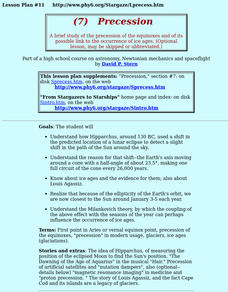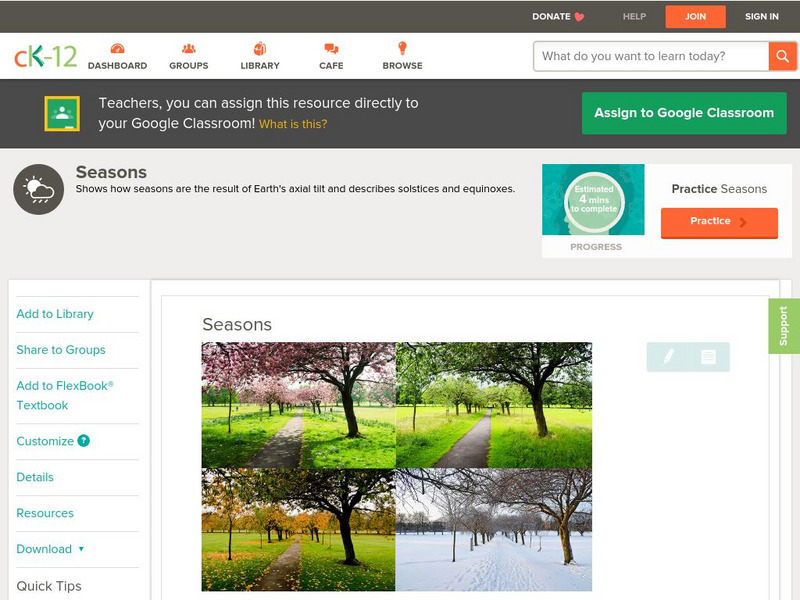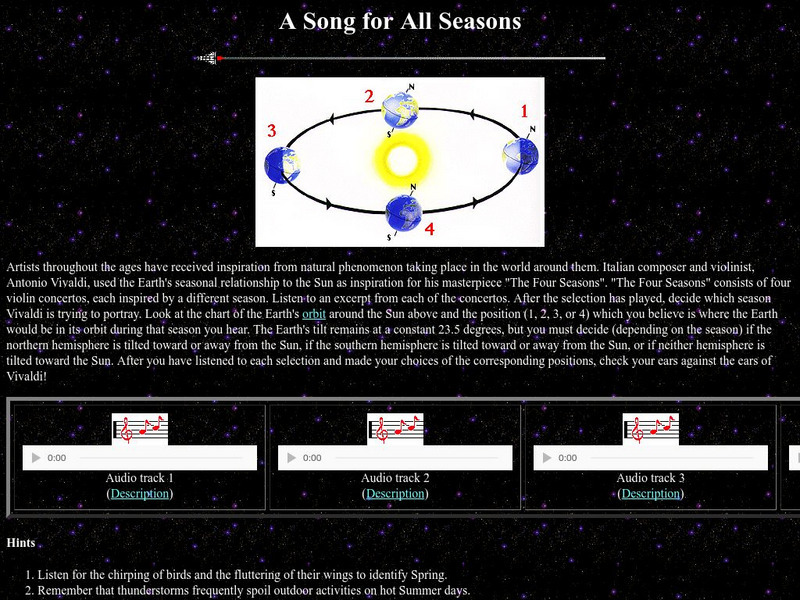Curated OER
Easter Word Search
In this Religion worksheet, students read an article about Easter and answer 19 questions that follow. They identify statements according to the article whether true and false. Students also complete sentences using the vocabulary terms...
Curated OER
The Sun: Earth's External Heat Engine Part 1 of the Astronomy Model
Students become familiar with the variables that control Earth's solar energy supply. They explore the source and nature of solar energy, the genesis of radiation, and the structrue of the Sun, gas spectra are observed and sample...
Curated OER
Making Sense Of A Round World On A Flat Surface
Young scholars engage in a instructional activity that is concerned with the development of geography skills. They take part in a number of activities that center around finding and traveling to different locations. The instructional...
Curated OER
Exploring the Night Sky: Fall/Winter
Students explain how moon phases occur. They explain three ways that the night sky has been used through history. Students locate some of the constellations in the night sky. They discuss stories and myths surrounding stars.
Curated OER
Precession
Students explain how Hipparchus, around 130 BC, used a shift in the predicted location of a lunar eclipse to detect a slight shift in the path of the Sun around the sky. They examine the elliptical orbit in which the Earth travels around...
Curated OER
Vocabulary Quiz: Grade Three
For this vocabulary worksheet, students match vocabulary words to the left with definitions to the right, 15 total. Worksheet contains links to additional activities.
Scholastic
Scholastic: Web Hunt: Vernal Equinox
Learn about the vernal equinox by completing this web hunt.
Exploratorium
Exploratorium:seasons/shadows: Investigate How Shadows Shift Throughout the Year
Ancient Chacoans used shadows to tell daily time and seasons. Build a model that demonstrates the changes in Earth's tilt that affect the length of shadows relative to the sun that determines the seasons. The lesson plan uses everyday...
Teachnology
Teachnology: Fall (Autumn) Season Teaching Theme
Be equipped with these resources to enhance classroom teaching about the fall season. Teachnology offers worksheets, lesson plans, and more.
Oklahoma Mesonet
Oklahoma Climatological Survey: The Seasons
Find out what the seasons are and how they change. Through the use of excellent graphics, content explores the Earth's orbit around the sun and how sunlight reaches the earth at equinox and the winter solstice.
Annenberg Foundation
Annenberg Learner: Journey North: Sunlight and the Seasons
This student observation guide walks learners through setting up an investigation of the seasons and their causes. Students can report their actual data right there on the page.
CK-12 Foundation
Ck 12: Earth Science: Seasons
[Free Registration/Login may be required to access all resource tools.] Describes how and why seasons occur.
CK-12 Foundation
Ck 12: Earth Science: Seasons
[Free Registration/Login may be required to access all resource tools.] Learn how and why seasons occur.
NASA
Nasa Star Child: A Song for All Seasons
After listening to excerpts from four of the violin concertos from "The Four Seasons" by Italian composer and violinist, Antonio Vivaldi, decide which excerpt was meant to go with which season, and also decide where the earth would be in...
Environmental Education for Kids
Eek!: Seasonal Observations: Fall
Fall begins with the autumnal equinox, usually around September 22 or 23. The equinox is the time of the year when we have equal length of night and day.
Environmental Education for Kids
Eek!: Seasonal Observations: Summer
While many of us consider it summer once school is released, this season technically begins with the summer solstice - the longest day of the year - on June 21 and continues until the fall equinox in September.
Environmental Education for Kids
Eek!: Seasonal Observations: Winter
The shortest day of the year, or the winter solstice, marks the beginning of this season usually occurs around December 21. Bundle up because winter is a fantastic time to track animals and explore the outdoors!
Environmental Education for Kids
Eek!: Seasonal Observations: Spring
Say good-bye to cold temperatures and short days, spring is here!! Mud puddles, blossoms, songbirds are just a few things that call us outdoors during this season. Start here for some cool ideas to celebrate spring!
Math Is Fun
Math Is Fun: The Seasons
Learn about the four seasons, when they occur in the northern and southern hemispheres, and why the seasons change as the Earth rotates around the Sun.
University of Wisconsin
University of Wisconsin: Reasons for the Seasons
A brief explanation of the Earth's rotation around the Sun and how it relates to the amount of sunlight the Earth receives, and to the seasons. Includes two questions for students to respond to.
ClassFlow
Class Flow: Earth and Space the Seasons
[Free Registration/Login Required] This flipchart explores the relationship between the sun and earth and how the seasons happen. Vocabulary of the equinox, solstice, etc. is included.
Other
Lunar and Planetary Institute: Sky Tellers: Myths, Magic, Mysteries of Universe
Very nice website with excellent graphics depicting the change of the seasons and how the seasons are different between the northern and southern hemisphere. Also has a nice informational table of the spring and fall equinox and summer...
Other
Earth Sky: Everything You Need to Know: December Solstice 2014
Winter solstice, earliest sunset, latest sunrise. It seems that, in the Northern Hemisphere anyway, these three events should happen on the same day. Read this explanation of the changing of the seasons and learn why the winter solstice...
Georgia Department of Education
Ga Virtual Learning: Astronomy: The Earth
In this interactive tutorial students will learn what causes the seasons, diurnal cycles and how the constellations move through the sky. Learn we are able to see other planets and how astronomical events affected life on the Earth.




















